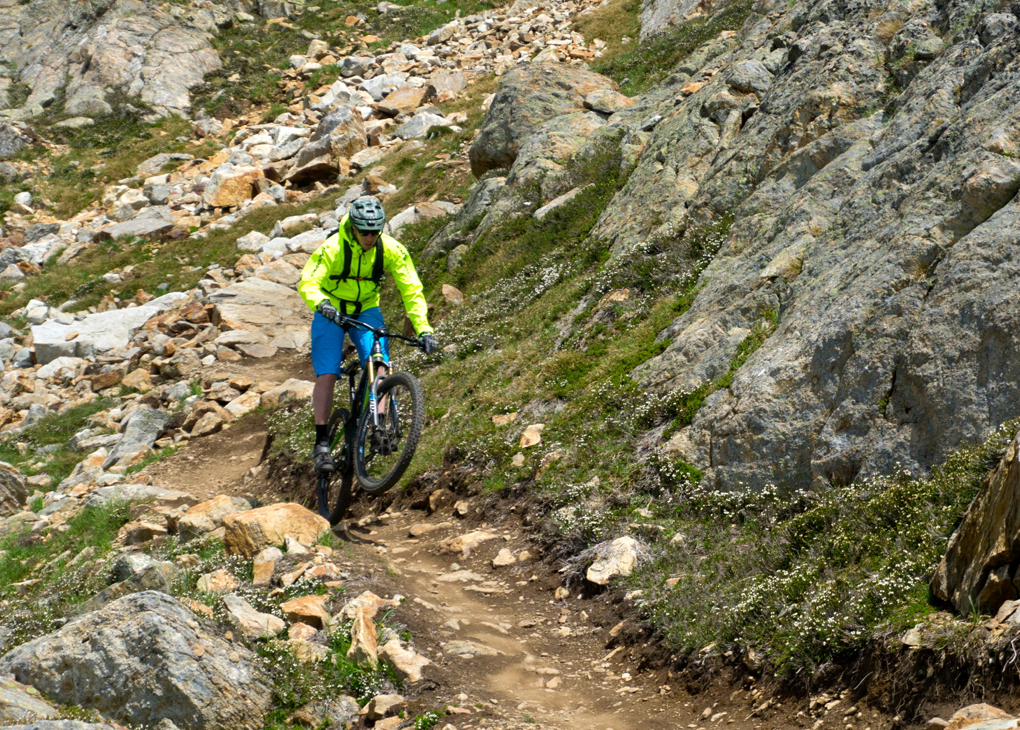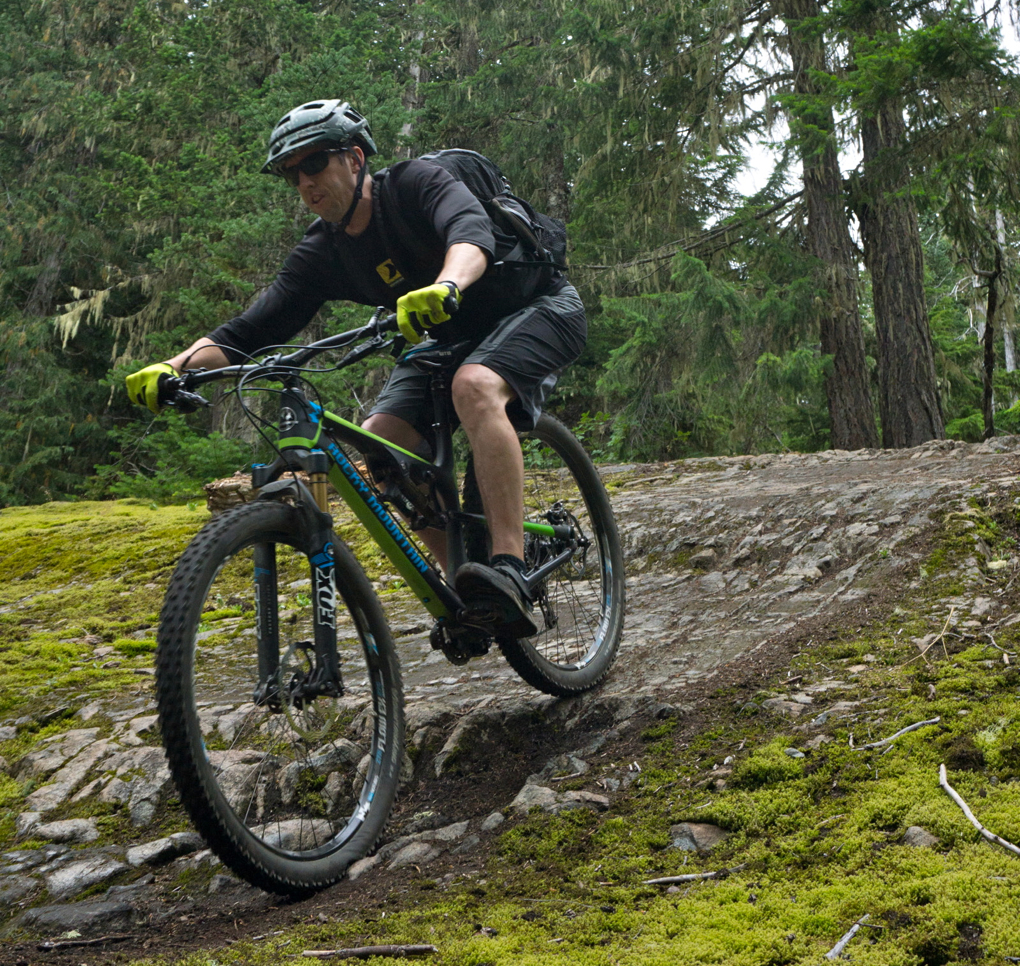The Ride
As I mentioned above, I was pretty happy with the fit and geometry of the bike, but I did struggle a bit to get the suspension set up to my liking. The fork wasn’t really a problem—it’s a normal 2014 Fox 34 that I’ve had some experience with. And while it’s not my favorite fork out there, it’s far better than the 2013 Fox 34.
But the rear suspension proved to be more difficult; I had a hard time finding a setting that felt good. To start with, the rebound knob is tucked away in a fairly inaccessible location. While this isn’t the end of the world, it is a bit inconvenient.
The real issue, though, is that I had a hard time getting the shock set to an air pressure that I was happy with. On my first ride, I set the sag around 30%, and pretty quickly noticed that I was blowing through the travel.
I then added pressure until I reached a point where I couldn’t easily bottom out the suspension just by thumping on it in the parking lot. At this point, I had around 180 psi in the shock, which is higher than I’ve ever run any shock on any other bike (I weigh around 155 lbs). This isn’t a problem in and of itself, but I still didn’t like how the suspension felt; it lost most of its small bump sensitivity, and I could still bottom it out a little easier than I would have liked.
Over the course of the week, I continued to play with the air pressure, and eventually landed somewhere in the middle, with sag a bit less than 25%. I also played with the Ride-9 chip a bit, and by moving the chip forward, got a bit more of a progressive curve out of the shock, which helped. I suspect that if I’d had the time to play around with the shock and the Ride-9 chip a bit more, I could have gotten the suspension feeling better.

That said, switching between the Rally Edition and some of the other bikes we were testing, like the Knolly Warden and the Specialized Enduro, I never felt like the rear suspension on the 770 MSL Rally was in the same ballpark as those bikes. Fine tuning the suspension made it better, but it never had the small bump sensitivity of the Enduro, and it blew through its travel more than either of those other bikes. The rear suspension on the Rally felt more like a shorter-travel trail bike than a 150mm travel bike meant to tackle the nastiest of trails.
This surprised me a bit. The Rally Edition has a fairly progressive leverage rate, so I don’t have any good explanation for why I was having such a hard time finding the middle ground between small bump sensitivity and bottoming out.
Notwithstanding the rear suspension, I got along with the Rally Edition pretty well. Even though it wasn’t smoothing out the trail quite as much as I would have liked, I felt like the bike as a whole rode quite well. Pretty much everything we rode in Whistler involved steep, rooty, rough descents that are a good test for any bike, and the Rally Edition handled it all gracefully.
On the climbs, the geometry of the Rally Edition kept it reasonably composed. There was some front end wandering on steep climbs, which is fairly typical of longer travel, slack bikes, but the Rally’s steep seat tube angle kept this to a minimum. I have to admit though, when the going got consistently steep, I got walking (see my drivetrain discussion above).
While the Rally’s rear pivot placement supposedly helps with pedaling efficiency, in reality, I didn’t find it to be particularly pedal friendly. To some extent, that sort of active rear end is good on techy, rooty climbs where the suspension does a good job of maintaining traction. But in terms of laying down power and efficiently driving the bike forward, the Rally Edition loses out to some of the other suspension designs on the market (e.g., DW and VPP bikes).
On the upside, the Rally Edition comes with a handlebar mounted remote for the rear CTD shock. This made it quick and painless to get the shock into climb mode, which significantly improved the bike’s uphill efficiency.
On the brakes, I never noticed the suspension doing anything noticeably unpleasant. Slamming it into hard corners, there’s a hint of flex in the rear end, which I’d probably attribute to the lengthy seatstays. But the rear end seemed to remain fairly active while braking through steep chunder.
The Rally Edition, like most of the new bikes in its class, is running 27.5” wheels. I honestly don’t have all that much to say about them; they roll over stuff marginally better than 26” wheels, and they’re a bit more of a chore in tight situations. But I don’t feel like they were a defining characteristic of the bike—nor do I find them to be a defining characteristic of most other 27.5” bikes I’ve ridden. In other words, while they make a noticeable difference, I don’t find that difference to be so dramatic as to significantly color my feelings toward the bike.

So, Who’s It For?
If you’re looking for a super plush, mini-DH bike, this probably isn’t the bike for you.
But if you’re coming from a more XC-oriented end of the spectrum and you’re looking to dip your toe into the “All Mountain” pond, the 770 MSL Rally Edition gives you a solid frame with solid parts, albeit without that deep, bottomless feel to the suspension.
And if you’re used to a shorter-travel bike that’s more about taking the edge off than swallowing water bars, the Rally will give you quite a bit more squish, but will still be manageable.
Bottom Line
The Rocky Mountain Altitude 770 MSL Rally Edition has a geometry that I felt very comfortable on, and the build was clearly put together by people who like to ride bikes hard. I found that I could take it on any trail—including fairly nasty ones—and be pretty happy.
The only real downside is that the rear suspension didn’t quite seem up to the task of rallying (pun intended) as hard as the rest of the bike wanted to. So, while the bike doesn’t smooth out rough trail quite as well as some of the competition, it’s nevertheless a pretty fun bike to go fast on through nasty terrain.
